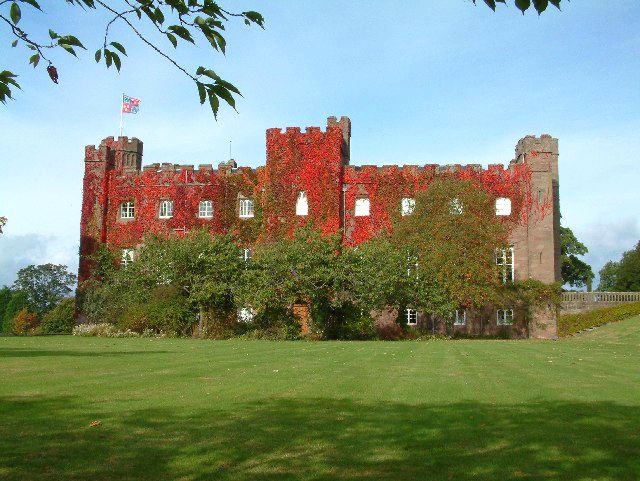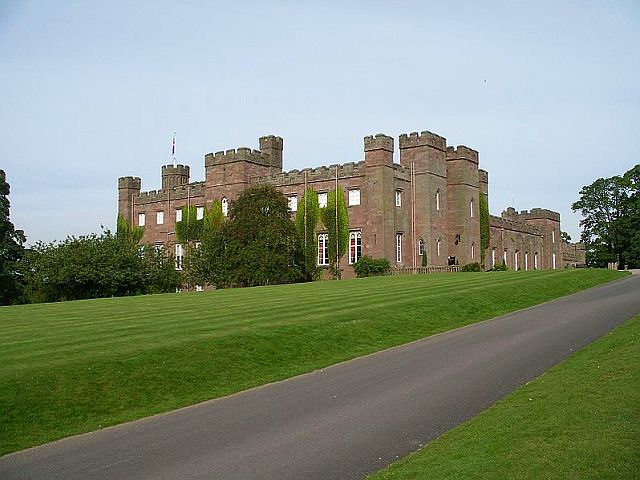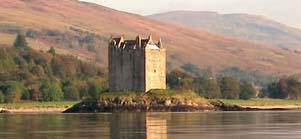
Scottish Castles
 Aberdeenshire Aberdeenshire
 Angus and Dundee Angus and Dundee
 Argyll and Bute Argyll and Bute
 Ayrshire and Arran Ayrshire and Arran
 Dumfries and Galloway Dumfries and Galloway
 Edinburgh and the Lothians Edinburgh and the Lothians
 Fife Fife
 Glasgow and Clyde Valley Glasgow and Clyde Valley
 Hebrides and Isles Hebrides and Isles
 Highlands Highlands
 Perthshire Perthshire
 Scottish Borders Scottish Borders
 Stirlingshire Stirlingshire
Local information
Accommodation in Perthshire
Perth & Kinross Highland Perthshire
|
Scone Palace, Perthshire
Location: Scotland, PH2 6BD (map and directions)
Scone Palace, just two miles north of the centre of Perth on the east bank of the River Tay, has
played a major role in the history of Scotland as the crowning place of the Kings of Scots and is the
home of the Stone of Destiny, also known as the Stone of Scone. 
Scone Palace © Peter Hodge
History of Scone PalaceThe current Category A-listed historic house as it stands today was constructed in 1808 for the
Earls of Mansfield. Its red sandstone facade and castellated roof serve as a classic example of the
late Georgian Gothic style.
The Earls of Mansfield continue to reside at Scone Palace, and the feel inside the castle is one
of a comfortable family home, albeit on an exceedingly grand scale. Inside the Palace are fine
collections of ceramics, clocks and furniture throughout the formal rooms and galleries of the
palace. A visit to the palace also includes a peek into the Dining Room which played host to
Queen Victoria and Prince Albert in September 1842, the Drawing Room, and the library, before
continuing on to the Long Gallery, the longest room of any house in Scotland at 150 ft (45m) long.
The 100 acres of Stone Palace grounds and gardens were landscaped by the 3rd Earl of Mansfield
in 1805 and are today open to the public, including a modern-day Murray Star Maze created of
hedges. Woodlands surround the property and are home to freely roaming peacocks, including
several albino males in addition to 250-year old fir trees including the Scone Douglas Fir, raised
from the original seed sent from America in 1826. During the landscaping, the Mansfields
expanded to include land which served as the village of Old Scone. Its residents were simply
removed and resettled in a new village, New Scone, one mile to the east. In what remains of Old
Scone is an ancient burial ground.
It is in the grounds, atop Moot Hill, where the chapel is located. The chapel was the coronation
site and where the Stone of Destiny was located until 1296. Legend says that Scotland is named
after an Egyptian princess, Scota, exiled from Egypt in 1400BC. Her descendants migrated to
Spain, then Ireland, and eventually to Argyll in western Scotland. Among the possessions which
Scota took from Egypt was a 152kg sandstone block used as a pillow by Jacob when he dreamed
about Jacobís Ladder. This became the Stone of Destiny during a time when the now Scoti
people crowned their Kings of Dalriada. The last King of Scots of Dalriada was Kenneth I, after the
kingdom suffered a serious defeat by the Vikings. Using his motherís bloodline, Kenneth laid claim
to the throne of the Picts, who had used Scone as a centre of centuries, thus becoming King of the
Picts and Scots, and using the Stone of Destiny to legitimate the crowning ceremony.

Scone Palace © Shadowgate
In 1114 Alexander I founded an Augustinian priory on the land of Scone Palace, becoming an
abbey 50 years later. In 1210 the Parliament of Scotland first met at Scone, a tradition which
continued to 1450, thus solidifying the significance of Scone in Scottish history.
During Edward I of Englandís invasion of Scotland in 1296, many of the countries symbols of
nationhood were taken, and this included the Stone of Destiny, which was removed to Westminster
Abbey. The Stone formed a part of the throne used during the coronation of English and British
monarchs, including Queen Elizabeth in 1953. Despite the Stoneís disappearance, Scone Palace was the coronation site for Robert the Bruce in 1306, James IV in 1488 and Charles II in
1651.Today the Stone of Destiny is back in Scotland, in Edinburgh Castle.
In the year 1559, Scone Palace was largely destroyed by a mob from Dundee, when the
property was in the hands of Lord Ruthven, Earl of Gowrie, whose main estate was that near
Huntingtower Castle. It was the Ruthvens who rebuilt the palace into a grand residence. In 1600,
however, the Ruthvens were charged with treason, and Scone Palace was passed to Sir David
Murray, one of Jamesí local followers. The Murray family has since resided at Scone for over
four centuries, with William Murray, in 1776, having been given the title of the Earl of Mansfield. Scone Palace is open to the public 7 days a week from April to 31 October from 9:30-5:30, earlier
on Saturdays.
View Scone Palace in a larger map
|
Other castles in Perthshire
 Ashintully Castle Ashintully Castle
 Balhousie Castle Balhousie Castle
 Balloch Castle Balloch Castle
 Balvaird Castle Balvaird Castle
 Blair Castle Blair Castle
 Burleigh Castle Burleigh Castle
 Drummond Castle Drummond Castle
 Elcho Castle Elcho Castle
 Fingask Castle Fingask Castle
 Finlarig Castle Finlarig Castle
 Huntingtower Castle Huntingtower Castle
 Castle Huntly Castle Huntly
 Kincardine Castle Kincardine Castle
 Kinfauns Castle Kinfauns Castle
 Lochleven Castle Lochleven Castle
 Meggernie Castle Meggernie Castle
 Methven Castle Methven Castle
 Scone Palace Scone Palace
 Taymouth Castle Taymouth Castle
|


 Aberdeenshire
Aberdeenshire Angus and Dundee
Angus and Dundee Argyll and Bute
Argyll and Bute Ayrshire and Arran
Ayrshire and Arran Dumfries and Galloway
Dumfries and Galloway Edinburgh and the Lothians
Edinburgh and the Lothians Fife
Fife Glasgow and Clyde Valley
Glasgow and Clyde Valley Hebrides and Isles
Hebrides and Isles Highlands
Highlands Perthshire
Perthshire Scottish Borders
Scottish Borders Stirlingshire
Stirlingshire

 Ashintully Castle
Ashintully Castle Balhousie Castle
Balhousie Castle Balloch Castle
Balloch Castle Balvaird Castle
Balvaird Castle Blair Castle
Blair Castle Burleigh Castle
Burleigh Castle Drummond Castle
Drummond Castle Elcho Castle
Elcho Castle Fingask Castle
Fingask Castle Finlarig Castle
Finlarig Castle Huntingtower Castle
Huntingtower Castle Castle Huntly
Castle Huntly Kincardine Castle
Kincardine Castle Kinfauns Castle
Kinfauns Castle Lochleven Castle
Lochleven Castle Meggernie Castle
Meggernie Castle Methven Castle
Methven Castle Scone Palace
Scone Palace  Taymouth Castle
Taymouth Castle